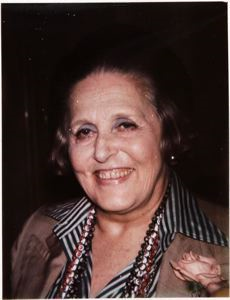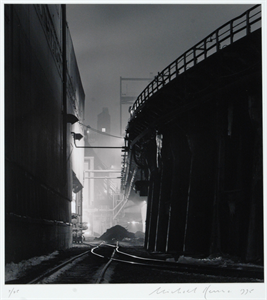
Andy Warhol
American, 1928–1987
From Little Red Book F126
Andy Warhol created thousands of instant Polaroid images during the 1970s. For the artist, the Polaroid camera allowed him to explore the photograph as a readymade while also commenting on the society’s throwaway culture. While Warhol created many of the Polaroids to use later in prints and paintings, the great bulk of the images (nearly 40,000) were informal snapshots of friends captured while traveling, at parties, or at the Factory. After taking a group of images that he particularly liked, Warhol carefully edited and sequenced them into small albums of approximately 20 images—Little Red Books. Warhol titled the books after the propagandistic book Quotations From Chairman Mao Tse-Tung, 1964, known in the West as the Little Red Book.
More than 100 of these books exist, and Warhol dedicated each one to a particular event. In the case of Red Book F126, a trip to Venice in May 1972 is the subject. He depicts an outing on a boat and a gathering with Countess Nathalie Volpi, actor Michael York and his wife Pat, the artist and jeweler Lisa Sotilis, gallery dealer Alexander Iolas, and French novelist, artist, and actor Francois-Marie Banier, among others. These images display a different aspect of Warhol’s artistic output. Lighting, framing, and focus did not concern him in these photographs; instead they are spontaneous, casual, intimate, and almost affectionate in nature and not intended as source imagery for his paintings or prints. The albums take on aspects of a visual diary, providing insights into Warhol’s personal life by showcasing him at play and while traveling with a variety of companions. They also function as a historical record or the time, chronicling the clothing, hairstyles, and jewelry of the early 1970s.
In many ways, Warhol’s casual Polaroids are a precursor to the type of imagery that now saturates the media and feeds America’s insatiable appetite for a glimpse into the lives of the rich and famous. Even Warhol would likely be surprised at the depth of fascination people hold for those who receive fifteen minutes (or more) of fame today.
American, 1928–1987
Countess Volpi
May 1972From Little Red Book F126
Object Type:
Photograph
Dimensions:
4 1/4 x 3 3/8 in. (10.8 x 8.57 cm)
Medium and Support:
Polacolor Type 108 on paper
Accession Number:
2013.0016.0019
Credit Line:
Gift of The Andy Warhol Foundation for the Visual Arts
Copyright:
© Andy Warhol Foundation / Artists Rights Society (ARS), New York
Andy Warhol created thousands of instant Polaroid images during the 1970s. For the artist, the Polaroid camera allowed him to explore the photograph as a readymade while also commenting on the society’s throwaway culture. While Warhol created many of the Polaroids to use later in prints and paintings, the great bulk of the images (nearly 40,000) were informal snapshots of friends captured while traveling, at parties, or at the Factory. After taking a group of images that he particularly liked, Warhol carefully edited and sequenced them into small albums of approximately 20 images—Little Red Books. Warhol titled the books after the propagandistic book Quotations From Chairman Mao Tse-Tung, 1964, known in the West as the Little Red Book.
More than 100 of these books exist, and Warhol dedicated each one to a particular event. In the case of Red Book F126, a trip to Venice in May 1972 is the subject. He depicts an outing on a boat and a gathering with Countess Nathalie Volpi, actor Michael York and his wife Pat, the artist and jeweler Lisa Sotilis, gallery dealer Alexander Iolas, and French novelist, artist, and actor Francois-Marie Banier, among others. These images display a different aspect of Warhol’s artistic output. Lighting, framing, and focus did not concern him in these photographs; instead they are spontaneous, casual, intimate, and almost affectionate in nature and not intended as source imagery for his paintings or prints. The albums take on aspects of a visual diary, providing insights into Warhol’s personal life by showcasing him at play and while traveling with a variety of companions. They also function as a historical record or the time, chronicling the clothing, hairstyles, and jewelry of the early 1970s.
In many ways, Warhol’s casual Polaroids are a precursor to the type of imagery that now saturates the media and feeds America’s insatiable appetite for a glimpse into the lives of the rich and famous. Even Warhol would likely be surprised at the depth of fascination people hold for those who receive fifteen minutes (or more) of fame today.
Keywords
Click a term to view the records with the same keyword
Related Objects
Click a record to view

Little Red Book F126 (Photograph Album)
2013.0016.0021
Related Objects
Click a record to view

Canal In Venice
2013.0016.0001

Marie Russell's Daughter
2013.0016.0002

Marie Russell's Daughter
2013.0016.0003

Marie Russell's Daughter
2013.0016.0004

Marie Russell's Daughter
2013.0016.0005

Michael and Pat York, and Unidentified Man
2013.0016.0006

Unidentified Woman
2013.0016.0007

Countess Nathalie Volpi and Unidentified Woman
2013.0016.0008

Marie Russell's Daughter
2013.0016.0009

Alexander Iolas
2013.0016.0010

Francois-Marie Banier
2013.0016.0011

Lisa Sotilis
2013.0016.0012

Francois-Marie Banier and Countess Volpi
2013.0016.0013

Alexander Iolas
2013.0016.0014

Countess Nathalie Volpi
2013.0016.0015

Alexander Iolas
2013.0016.0016

Unidentified Woman
2013.0016.0017

Alexander Iolas
2013.0016.0018

Lisa Sotilis
2013.0016.0020
Portfolio List
Click a portfolio name to view all the objects in that portfolio
This object is a member of the following portfolios:
Your current search criteria is: Portfolio is "Artist Name: W".

 by Artist (36)
by Artist (36)
